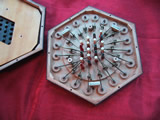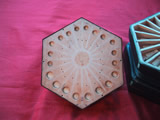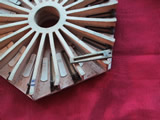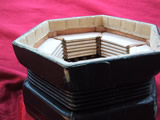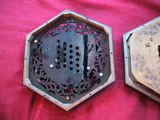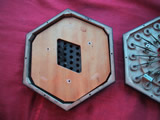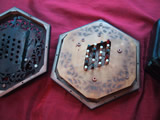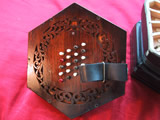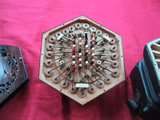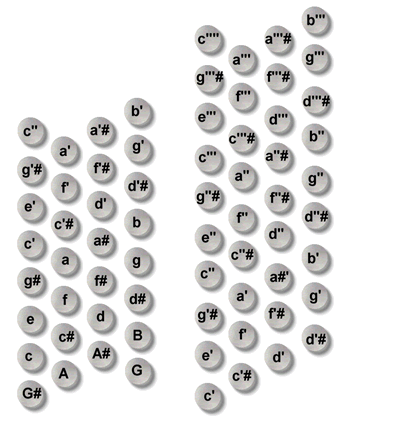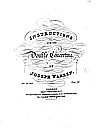Early Wheatstone Double Duet No. 23
This instrument was bought from a seller on eBay
in February 2003. The seller's family tradition was that it had been
bought for his grandmother to accompany her singing while she was
living in Germany as a child with her family
during the years 1890-1902; she returned with it to New York (living at
50 Central Park West), and sang for Teddy Roosevelt at a White House
ball in 1907 (whether the concertina went to the White House is not recorded).
The instrument was inherited recently along with a rare New York printing
of Alsepti's tutor for English concertina—which must have been
a confusing guide to the Double.
It is in playable condition, with essentially all-original parts; all pieces
including the bellows are marked with stamps “L” or “R” and “23”.
The reeds are brass, secured with two screws, in square-ended brass reed-shoes. According
to Neil Wayne, square-ended reed shoes ceased to be used from early 1848, and the Wheatstone labels
changed the monarch's gender to “By Her Majesty’s Letters Patent ... ”
(as here) in late 1847; based on those points, an approximate
date for this instrument would be 1847-1848, corresponding roughly to English concertinas numbered
around 1500–1600. That is consistent with the production ledgers,
which show the first units being made in 1845 and ramping up very slowly—a total of 23 by
late 1847 is quite reasonable. The highest Double serial number known to Neil Wayne seems to
have been No. 58.
The early factory records show several different sizes being made. Danny Chapman's No. 14 is 67 keys,
a very large instrument in the English pattern; the Wheatstone & Co. tutor shows a 57-key
instrument; and this No. 23 is only 45 keys, two octaves on the right and an octave and a half
on the left. (No. 23 measures 6 and 5/8 inches across.) It's probably true that no standard size
emerged during the brief experimental life of the
Double system. Like all known Doubles, it has English-style thumb-straps, but no rests for
the little fingers (although the pattern of the fretwork allows for them) which makes the
instrument harder to play. This lack is explained by
the tutor, which suggests that on each hand the four fingers be assigned to the corresponding
four columns of keys, leaving no extra fingers for support. The reed pans are
inclined on both sides (more sharply on the left) to produce deeper reed chambers for the
larger reeds and shallower reed chambers for the smaller reeds.
The original baffles intact in this No. 23 are very interesting. The perpetual topic
among modern duet players is how to balance the volume of the left end (normally louder) with
that of the right end (normally quieter), and one way is to install baffles with additional
baffling on the left end. This duet from 1847 does exactly that. It has “outer”
baffles of thin spruce mounted just below the fretwork above the action on both sides, just
like any English concertina of the same period, and
then on its left side—only—it has an additional “inner” shaped baffle
(also of spruce) screwed to a doughnut-shaped sycamore stand-off mounted around the central hole on the
inside of the left reed pan. This “inner” left-side baffle is asymmetrical and
covers all the larger reeds on the left side, leaving the left-side reeds which overlap with
the right end uncovered. This could have been an attempt to reduce the volume on the left
side smoothly, so that the same note was not quieter on the left and louder on the right.
Similar solutions for Maccann
duets, using removeable baffles made of other materials, are explained elsewhere on this website.
(See Baffles for Maccann Duet Concertinas.)
(Click on any small photograph in this document to see a larger version;
click ‘Back’ to return to this document.)
Wheatstone Double System Keyboard



